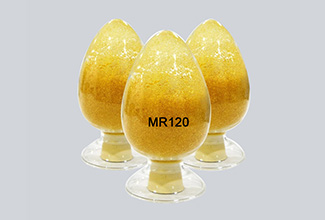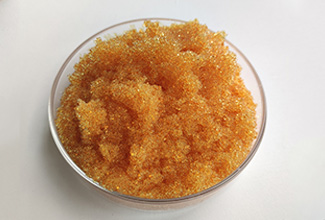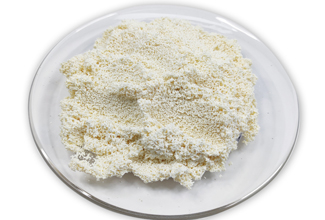What is the Theory of Ion Exchange Resin
The theory of ion exchange in fact can be summed up in one sentence: the high concentration ions in the solution and the loaded ions on the resin functional groups are exchanged under the promotion of the concentration difference, and the high concentration ions in the final solution hang on the resin. The loaded ions on the ions are displaced into the solution.
We take the 001×7 gel cation resin which usually used in the softening process of the boiler as an example to show the process situation:
Step1: the sulfonic acid functional groups are full of SO3-H which content H ions. this part of the H ions can freely diffuse and move in a certain range of the aqueous solution. We name it: resin standby state.
Step 2: Add large sum of the NaCL to the solution. Meanwhile, there will be lots of Na ions generated in the solutions. Due to the concentration gap, the high concentration will diffuse to the low concentration part, and the driving force of the concentration difference will push the Na ions to the SO3-H group. Near the cluster, the exchange of Na ions and H ions occurs, and the tube energy cluster changes to SO3-Na. We can call it: resin working state. SO3-H+NCl→SO3-Na+HCl (Note: This reaction is reversible, the middle arrow is bidirectional)
Step 3: continuously replenish NaCl, the exchange process will continue to the right, so that the H on the sulfonic acid group of the resin will become more and more less, on the contrary, the Na ions will become more, and finally all the Na ions will totally be covered. In this way, saturation exchange of the resin is achieved. We can call it: resin exchange (adsorption) saturation state.
From all above, the resin has completed the working process, and the next step is to regenerate the resin.
Step 4: The same principle as the adsorption of Na ions, we add a lot of fresh hydrochloric acid, sulfuric acid, etc. to the solution to ensure a high concentration of H ions in the solution. At this time, the higher concentration of H ions is driven by the concentration difference. , migrated to the vicinity of the functional group covered with Na ions, exchanged with Na ions, the functional group recovered SO3-H, and Na was exchanged into the solution. We can call it: the regeneration process of resin.
For the same reason, the exchange principle of anion resin is also to realize the exchange of anions through the effect of concentration difference. For example, the OH supported by the functional group of the anion resin is exchanged with the Cl ions in the solution, and the OH and free H under the exchange are neutralized into water. , the regeneration process is reversed.
We take the 001×7 gel cation resin which usually used in the softening process of the boiler as an example to show the process situation:
Step1: the sulfonic acid functional groups are full of SO3-H which content H ions. this part of the H ions can freely diffuse and move in a certain range of the aqueous solution. We name it: resin standby state.
Step 2: Add large sum of the NaCL to the solution. Meanwhile, there will be lots of Na ions generated in the solutions. Due to the concentration gap, the high concentration will diffuse to the low concentration part, and the driving force of the concentration difference will push the Na ions to the SO3-H group. Near the cluster, the exchange of Na ions and H ions occurs, and the tube energy cluster changes to SO3-Na. We can call it: resin working state. SO3-H+NCl→SO3-Na+HCl (Note: This reaction is reversible, the middle arrow is bidirectional)
Step 3: continuously replenish NaCl, the exchange process will continue to the right, so that the H on the sulfonic acid group of the resin will become more and more less, on the contrary, the Na ions will become more, and finally all the Na ions will totally be covered. In this way, saturation exchange of the resin is achieved. We can call it: resin exchange (adsorption) saturation state.
From all above, the resin has completed the working process, and the next step is to regenerate the resin.
Step 4: The same principle as the adsorption of Na ions, we add a lot of fresh hydrochloric acid, sulfuric acid, etc. to the solution to ensure a high concentration of H ions in the solution. At this time, the higher concentration of H ions is driven by the concentration difference. , migrated to the vicinity of the functional group covered with Na ions, exchanged with Na ions, the functional group recovered SO3-H, and Na was exchanged into the solution. We can call it: the regeneration process of resin.
For the same reason, the exchange principle of anion resin is also to realize the exchange of anions through the effect of concentration difference. For example, the OH supported by the functional group of the anion resin is exchanged with the Cl ions in the solution, and the OH and free H under the exchange are neutralized into water. , the regeneration process is reversed.
Next Article :
Related Products
-
 MR120 Electronic Grade Polishing Ion Exchange ResinAppearance: Yellow-brown spherical particles.Ionic form:H+/OH-Volume complete exchange capacity(mmol/ml):≥0.6
MR120 Electronic Grade Polishing Ion Exchange ResinAppearance: Yellow-brown spherical particles.Ionic form:H+/OH-Volume complete exchange capacity(mmol/ml):≥0.6 -
 C007FG Food Grade Cation Exchange Resin for Drinking Water SofteningAppearance: Claybank to tan transparent spherical particle.The degree of crosslinking : 7%.Ionic form: Na+
C007FG Food Grade Cation Exchange Resin for Drinking Water SofteningAppearance: Claybank to tan transparent spherical particle.The degree of crosslinking : 7%.Ionic form: Na+ -
 Boron Absorbing Resin Macroporous Ion Exchange Chelating ResinAppearance: Creamy to beige opaque beadsIonic form: Free baseVolume complete exchange capacity(mmol/ml): ≥0.80
Boron Absorbing Resin Macroporous Ion Exchange Chelating ResinAppearance: Creamy to beige opaque beadsIonic form: Free baseVolume complete exchange capacity(mmol/ml): ≥0.80
Message

